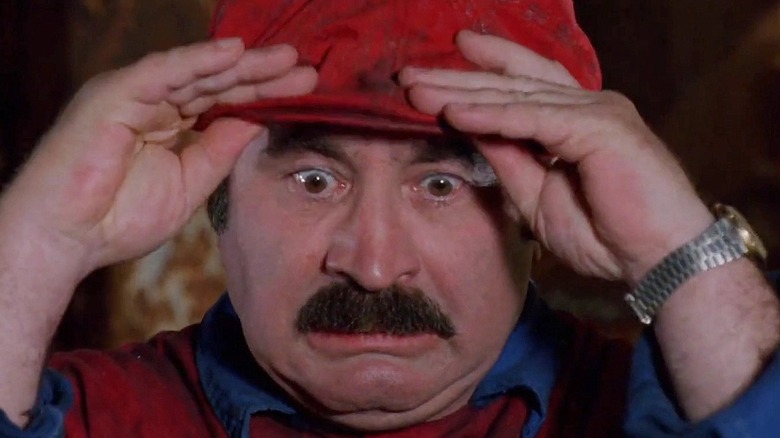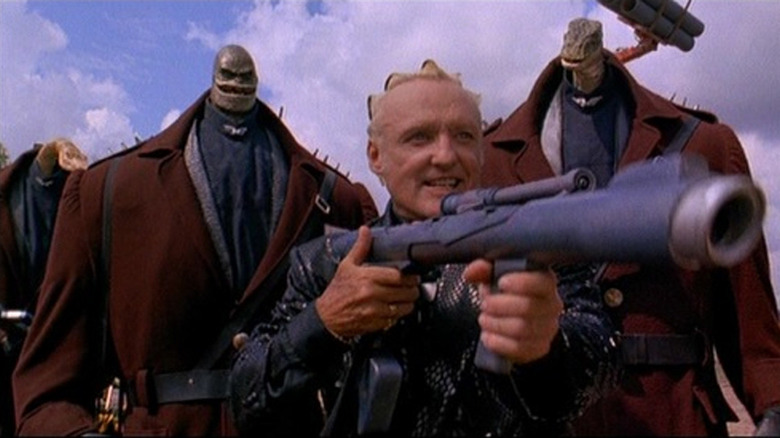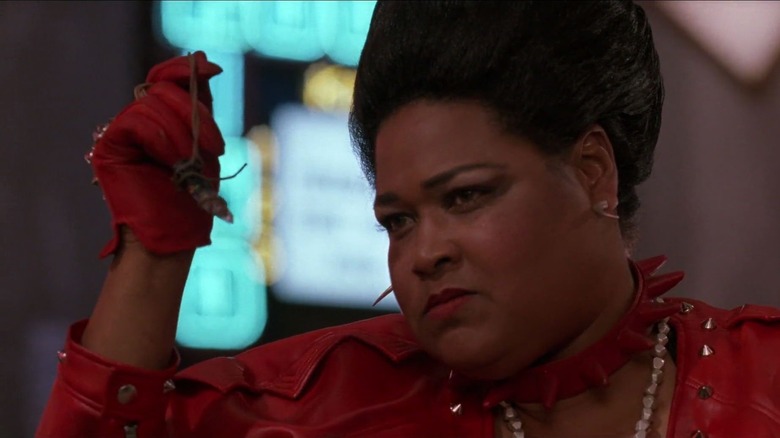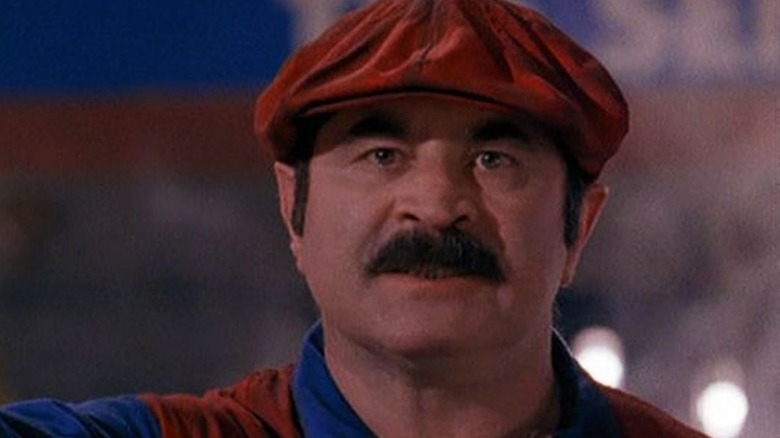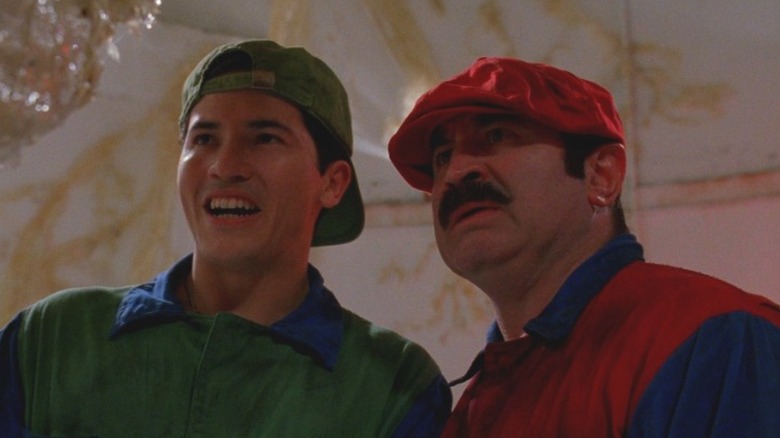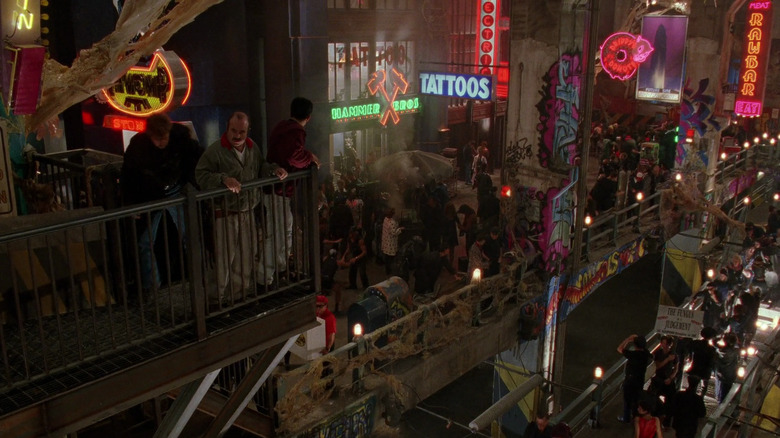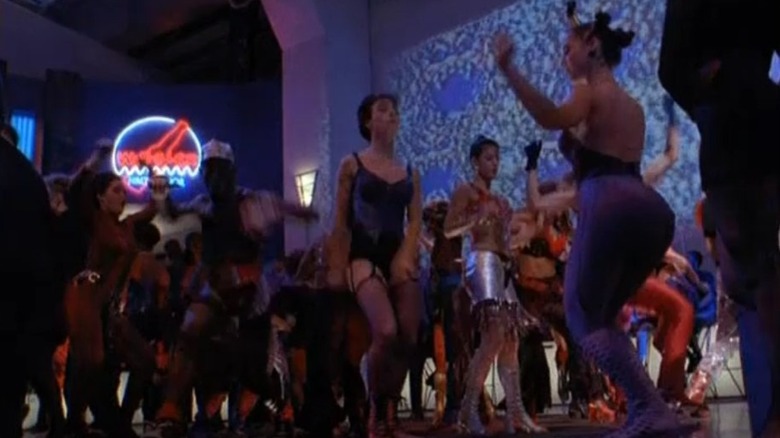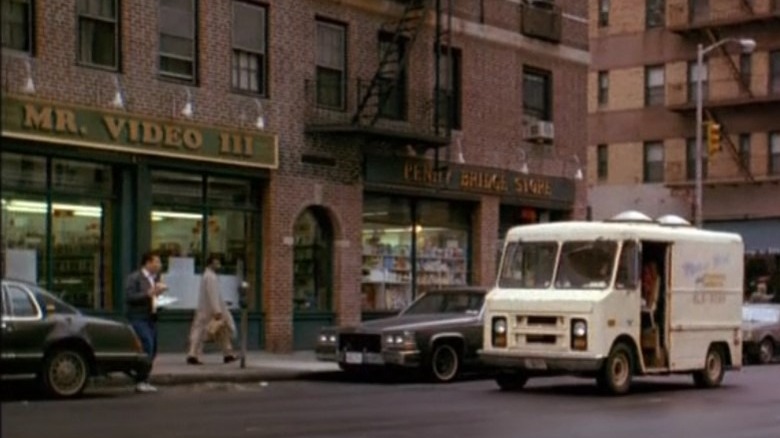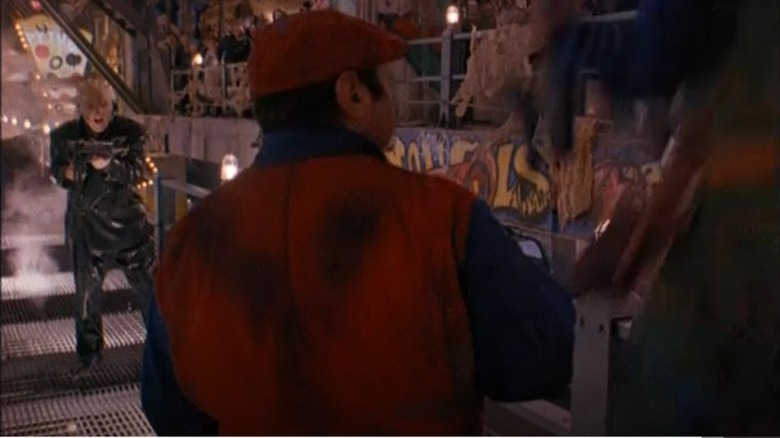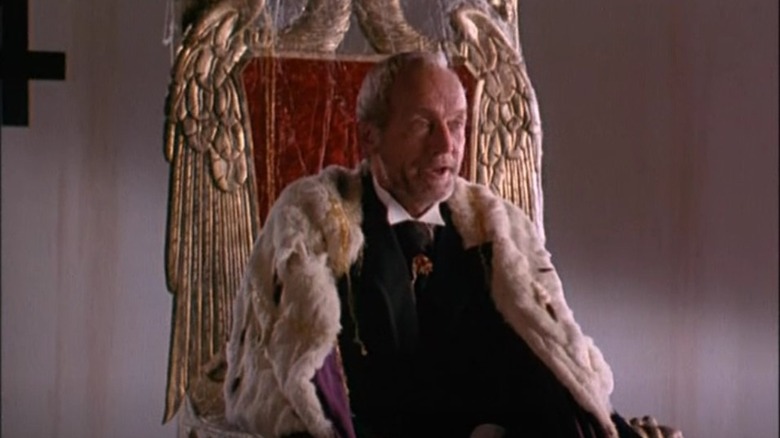Easter Eggs You Missed In The Original Super Mario Bros. Movie
While the "Super Mario Bros." movie was widely disliked by critics and audiences alike upon release, it was notably the very first Hollywood movie based on a video game. Over the years, it has achieved a cult status among "Super Mario" fans, similar to other infamously bad movies like "The Room" or "Birdemic."
The movie is particularly strange because of how little it has to do with the video game series. The movie's directors didn't want the movie to feel too much like the source material, so they decided to make it grittier and set it a city inspired by "Blade Runner" and "Die Hard," rather than the whimsical Mushroom Kingdom.
Of course, there are some elements of "Super Mario" that the movie could not shake off, so Mario and Luigi are both present, while Daisy is now an archaeology student in college (who somehow digs for fossils in New York City). The movie also prominently included things like Bob-ombs, power-up mushrooms, and Goombas, even if they look more like Godzilla's weird offspring than what fans of the series are used to. However, many of the movie's easter eggs are cleverly hidden throughout the movie.
The Nintendo Super Scope
One of the more well-known easter eggs among diehard fans of the movie is the inclusion of the Nintendo Super Scope. The peripheral was a first-party light gun that let players "shoot" targets in games by simply pointing it at their TV and pulling the trigger. The Nintendo Super Scope was the follow-up to the very successful NES Zapper, but it never reached the same level of fame due to its bulkiness and comparative complexity (per Nintendo Life).
However, the "Super Mario Bros." movie also reveals that all one needs to turn the Nintendo Super Scope into a high-tech "de-evolution ray" is some gray paint. The peripheral makes its appearance in the climax of the movie as King Koopa — the film's version of Bowser, played by Dennis Hopper — threatens to shoot the heroes with it and de-evolve them to an earlier form. The Super Scope's cameo in the movie was even used in ad campaigns in Japan to try and sell it. Many modern viewers of the movie, however, might not recognize the de-evolution ray for what it truly is, especially as the industry gets further and further away from the SNES and its peripherals.
Mario enemies turned human
One of the biggest draws of the "Super Mario Bros." movie is the opportunity for fans of the games to see their favorite characters in an entirely new way. Although many of these game-to-movie translations are pretty obvious, there are two enemy appearances that are subtle enough for most fans to miss. The first of these is a woman in the city who is pushing around an egg in a stroller with distinct markings on her face. This character has been speculated by some fans to be a reference to Birdo, not only for the iconic egg, but also because the markings on the woman's face somewhat resemble Birdo's birthmarks.
The second occurs when Mario and Luigi go to a nightclub and Mario runs into a woman in a red dress who aggressively flirts with him. As noted by Syfy, this character is the movie's version of Big Bertha, a massive fish that attacks players in some of the games. Not only do her dress and makeup match the color scheme of the video game character, but Big Bertha is also notorious for having a romantic fascination with Mario in the franchise's comics. Big Bertha's inclusion is perhaps one of the most obtuse throughout the movie, but it is still a cool nod for fans who are able to piece the clues together.
Bob Hoskins' Plaster Cast
The production of "Super Mario Bros." was notoriously hazardous and chaotic. The script received daily rewrites, and lead actors John Leguizamo and Bob Hoskins (Luigi and Mario, respectively) have both spoken openly about the dangerous conditions that the movie was produced in. Bob Hoskins even said in a Q&A with The Guardian that making the movie was his biggest regret.
Not only that, but both actors received a number of injuries while on set, with Hoskins saying that his injuries included electrocution, stabbings, and near-drowning. One of the actor's smaller incidents, however, left visible evidence in the rest of the movie for viewers to try and spot.
The injury occurred when Hoskins had his hand crushed in the closing door of a van, breaking one of his fingers. As the movie was already behind schedule and way over budget, filming could not stop, leading to Hoskins filming the remainder of his scenes with a plaster cast on his hand. To keep the cast from being distractingly obvious during those scenes, it was painted to look closer to Hoskins' skin tone. This was preferable to leaving it a bright white, but it was not a perfect fix. Viewers who look for the cast can find it throughout the movie — and they may also notice that Mario's hand doesn't always move quite as much as it should.
John Leguizamo's leg cast
John Leguizamo also suffered an injury during filming that caused him to wear a cast visible in the final film. Leguizamo's injury reportedly happened (per The Guardian) because the actor was intoxicated from drinking in-between takes with Hoskins throughout production. Leguizamo ended up breaking his leg after walking in front of a car that he didn't see. Again, the movie could not afford to pause production for the actor to heal up, meaning that he had to film a number of scenes while attempting to hide his leg cast from the camera.
Thankfully, Leguizamo's cast is not nearly as noticeable as Hoskins', since it is often hidden beneath the actor's costume. Despite this, its presence can still be noted, either by the cast bulging underneath Leguizamo's pants or by the actor struggling to obscure his limp as he attempts to walk and run. Leguizamo discussed his struggles while filming the project extensively in his autobiography, in which he also detailing some of the other harrowing events on the set, such as one of the movie's directors pouring hot coffee on an extra because he didn't like their costume.
Neon Signs
A number of Mario's enemies are also referenced through neon signs that are dotted throughout the grungy scenery of the film. The most recognizable may be the Bullet Bill signs, as they are some of the most iconic enemies throughout the series. The giant falling stone enemy called a Thwomp is also referenced, both in a neon sign and in the Thwomp Stomper boots that Mario and Luigi don to help them jump higher. As an added bonus, the cartridges that fire from these boots are also tiny little Bullet Bills.
The film's more obscure neon signs cover an impressive range of "Super Mario" enemies. A Hammer Bro appears in a sign a sign advertising a tattoo parlor, the giant yellow worm known as Wiggler apparently has an alcoholic drink company, and even the Fire Snake from the desert areas of the games is represented in glowing neon tubes.
Other signs simply feature character names, including shoutouts to the "Super Mario Bros. 3" boss Boom Boom, the undead Fishbone from "Super Mario World," and the scorching Fry Guy from "Super Mario Bros. 2."
Bowser's Cave
One of the most iconic images from "Super Mario World" was the entrance to Bowser's Cave, the location of the game's final world. In the middle of the ocean, players find an island in the shape of the evil dragon's head. This design is included in the movie, although in a subtle way. The sprite is included in the same scene as Big Bertha, when Mario and Luigi go to the nightclub in the heart of Dinohattan.
At the nightclub, a variety of images are projected onto the walls to add to the ambiance. These images constantly spin and scale with the music, distorting any clear view of what they really are. One of the more prominently featured images is a creepy shot of Bowser's Cave, which is shown in its full glory in a repeated pattern. The Koopa Tower location in the movie also has recognizable rectangular panels on its interior walls, which appear to be a direct nod to the grey blocks that make up the interior of the castles in "Super Mario 3."
Mr. Video
At certain points in the movie, Mario and Luigi drive past a video rental store named Mr. Video III. The video store was real and functional at the time, and while it may seem like an accidental or circumstantial inclusion that came about via filming the movie in Brooklyn, the store is specifically driven past by the brothers a total of three times. The video store likely doesn't stick out for most viewers, but "Super Mario" fans that are well versed in the character's history may have picked up on something more.
The particular part of that history comes from when Shigeru Miyamoto was first creating Mario for his appearance in "Donkey Kong." Choosing Mario's name was not a simple process. According to Engadget, the character was originally referred to as Mr. Video before being renamed before the game's official launch. Of course, that was changed in the final moments, but the video store's name is a great nod towards a part of Mario's history that many fans have never heard about. Interestingly, the name change also came with a decision at the time to give Mario the ability to jump. It is pretty crazy to imagine just how different a "Super Mr. Video" series would look with players not even being able to jump.
The connection may not be intention — after all, the shop already existed — but fans of the games may see this shop's presence as a kind of cosmic connection.
The Showdown on the Bridge
One of the most memorable parts of the original "Mario" game was facing off against Bowser on a bridge suspended over lava. There, players have to avoid Bowser to reach an ax that falls and collapses the bridge, causing Bowser to fall into the lava. Obviously, the lava isn't enough to put an end to Bowser; after all, he is alive and well in the mainline games of the series and many of the spin-offs.
The "Super Mario Bros." movie references this famous moment from the games in its climax, during which Mario and King Koopa face off against one another on an industrial walkway that mimics a bridge. However, King Koopa is defeated in a very different way. While he is distracted on the walkway, Mario and Luigi send in a Bob-Omb that blows up underneath King Koopa, sending him flying and falling into a large metal pot. Then, they blast him with de-evolution guns until he turns into ooze.
While markedly different from the showdowns in the game, this final set piece at least made it clear that King Koopa was defeated for good on the first try. Maybe this is how all fights with Koopa on a bridge should play out.
Transforming King
Confusingly, the rightful ruler of Dinohattan is King Bowser (Lance Henrikson), a righteous and reasonable monarch who was turned into a giant sentient fungus by King Koopa. It seems very strange to name one of the movie's heroes after the usual series antagonist, but this decision was reportedly made during a series of extensive on-set script rewrites. At earlier points of production, the King had a number of different names and Bowser is only confirmed through the movie's novelization and screenplay; his name is never mentioned on-screen.
At the end of the movie, however, he is restored to his normal human form, allowing him to retake his throne and return Dinohattan to its former glory. This is another reference to "Super Mario Bros. 3" In that game, players move from land to land of a sprawling kingdom defeating a series of Koopalings, each of whom are revealed to be a king transformed by Bowser.
Once the Koopalings are defeated, the kings re-assume their human forms and take their rightful place on the throne, just like King Bowser does in the movie. As a matter of fact, monsters who end up transforming into humans pop up a lot in this franchise, as even Mario's earlier animated movie featured a similar scene in its conclusion.

